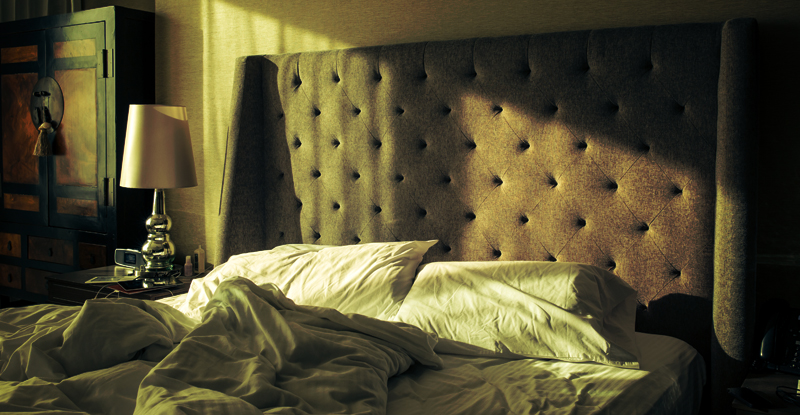Sleep tight & don’t let the bed bugs bite
The saying “sleep tight and don’t let the bed bugs bite” might seem like a bedtime joke, but for millions of Americans who travel each year it’s become no laughing matter. A serious national and even global health problem is the infestation of bed bugs. Estimates even reveal that about one out of every five Americans has had a bed bug infestation in their home or knows someone who has.
These tiny critters have created quite the buzz this year, so we investigated. Here are the answers to our bed bug frequently asked questions:
Are bed bugs a result of poor sanitary conditions or dirty homes and hotels?
No. Don’t be fooled by the star rating of your hotel or how nice it appears, as the presence of bed bugs is not determined by the cleanliness of the living conditions where they are found. Even the cleanest living areas are subject to infestations, and almost anyone can be at risk.
Who is at risk for bed bugs?
Everyone is at risk, especially those who travel frequently or share sleeping quarters with others. Hotels and travelers however aren’t the only ones at risk though. Many cities are experiencing increasing numbers of bedbug infestations in hospitals, office buildings, movie theaters, schools, and even on subways and trains, which in turn expands the number of people potentially exposed.
What do bed bugs look like?
Bed bugs are reddish-brown in color, and wingless, range from 1mm to 7mm. Their only source of food is the blood of people and animals. Bed bugs come out to feed every 5 to 10 days, but some experts believe that they can live up to a year without fresh blood.
What are the health risk of bed bugs?
The good news is that bed bugs aren’t known to spread disease but they can cause itching and lead to excessive scratching, which increases the risk of secondary infection. Bite reactions can range from no signs or symptoms at all to a serious allergic reaction requiring medical attention. Bite marks usually occur on the face, neck, arms, hands, or any other body parts exposed while sleeping. However, these bite marks may take as long as 14 days to develop in some people, so it is important to look for other clues when determining if bed bugs have infested an area.
Where do bed bugs hide?
Bed bugs like to live in darkness (but will enter the light to feed) and can hide under electric outlets, baseboards, loose wallpaper, carpet, mattress box springs, and bedding. They can even be found in furniture seams and between cushions and in furniture drawers. Because they are so small they can also fit into cracks and behind electrical receptacles and in some appliances.
What are signs of bed bugs in a hotel room?
To examine a room for bugs, you first want to put all luggage in the bathroom and then inspect the room by looking for:
- The bugs exoskeletons, which are tiny (about 1mm) and pale yellow.
- Live bugs in folds of the bedding and mattresses.
- Rusty colored spots (which are a result of blood and fecal material).
- An odor, with a “musty-sweetish” smell produced through glands on the lower side of the body.
It should be noted young bugs are smaller, translucent, or whitish-yellow in color and can be nearly invisible to the naked eye because of coloring and size.
How can you protect yourself from bed bugs?
In Public: The good news is that it’s unlikely your office or other non-residential environment will develop a bed bug infestation. However you do need to know that these sites can serve as a hub for the bugs to “hitchhike” rides into your home from an infected host. As a precaution, you want to keep your personal belongings (when possible) away from other people, be vigilant of areas where bugs may be found, and reduce clutter, as it’s an ideal habitat for the bugs.
At Home: You want to be cautious when purchasing used furniture, stuffed animals, clothing, or linens. Always inspect these items and wash in warm water and dry for at least 30 minutes on high heat before using them in your home. You also want to store luggage in the basement, attic, or garage and never under the bed, where the bugs could transfer from the luggage into the home. Also keep a neat and tidy home by cleaning daily and reducing clutter.
What should you do if you find bed bugs?
- If at a public place, inform the management and facility staff immediately and exit the area.
- If in your home, contact your local health department to see what resources are available and contact a professional pest company for an inspection.
What not to do if you have or think you have the bed bugs:
- Don’t panic and stay calm, as there are methods to control the infestation.
- Do not use chemicals or homemade products, as they could worsen the situation or be dangerous to everyone in the house.
- Throw away your furniture, as this will likely cause spread of the bugs to others. Beds and furniture can be properly treated. If you do discard items, prevent others from taking them in by marking with spray paint “bed bugs.”
- Do not clear out rooms or move items from room to room as you can increase the rate of spread.
- Kill the bed bugs by hand as you won’t be able to get them all and risk carrying to other locations.
By knowing what to be vigilant of and what to do if you suspect you’ve been bitten or have an infestation, you can save precious time and put a stop to a problem before it gets worse. For more information visit your local health department for guides, tips, and sightings in your area.
Resources:
Allegheny Health Department: www.achd.net/housing/bedbug.html
Centers for Disease Control and Prevention: www.cdc.gov/parasites/bedbugs/
High, W.A. (2017). “Bedbugs: Awareness is key.” Cleveland Clinic Journal of Medicine.
Preventing and Getting Rid of Bed Bugs Safely: www.achd.net/housing/pubs/pdf/NYC_BedBug_pamphelt.pdf
US National Library of Medicine: https://medlineplus.gov/bedbugs.html
United States Environmental Protection Agency: www.epa.gov/bedbugs/how-find-bed-bugs




